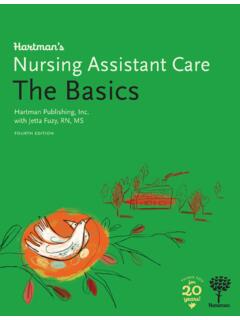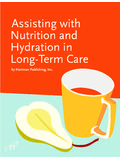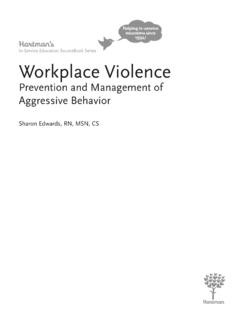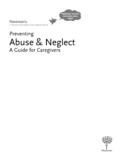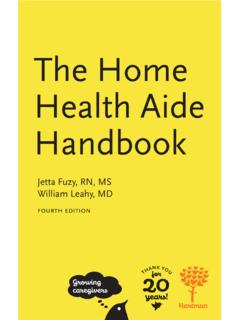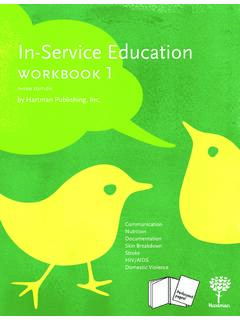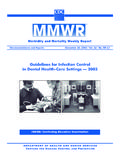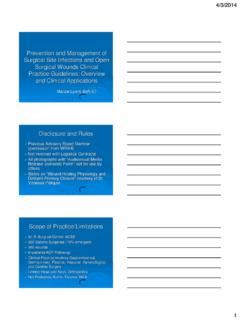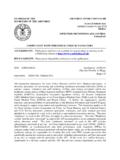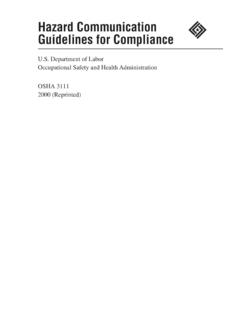Transcription of Infection Prevention Standard and Transmission …
1 Helping in-service educators since 1994!Hartman's In-Service Education SourceBook SeriesInfection PreventionStandard and Transmission -Based PrecautionsCharles A. Illian, RN, BSNsecond editionCharles A. Illian, RN, BSN, CICI nfection control Practitioner & ConsultantStaff Development EducatorOrlando, FloridaThe publisher gratefully acknowledges the contributions of thefollowing individuals who reviewed this material:Barbara Acello, MSEd, RNDenton, TexasJanet Ammons, RN, CIC, MedOld Hickory, TennesseeKathlene Benson, RN, BSNA ssociate DirectorFamily and Children s ServiceOakhurst, New JerseyJanet M. Hantsch, RN, BSStaff EducatorDu Page Convalescent CenterWheaton, IllinoisJean D. Lee, RNCS taff Development CoordinatorJill Holmes Long, RN, BS, BSN, MAPeachtree City, GeorgiaMaureen Powers, RNC, BSNS taff DevelopmentStephen Caldwell Convalescent HomeIpswich, MassachusettsThe New Infection control SystemStandard and Transmission -Based PrecautionsNOTICE TO THE READERT hough the guidelines contained in this text are based on consulta-tions with health care professionals, they should not be consideredabsolute recommendations.
2 The instructor and readers should followemployer, local, state, and federal guidelines concerning health care practices. These guidelines change, and it is the reader s responsibility tobe aware of these changes and of the policies and procedures of her orhis health care publisher, author, editors, and reviewers cannot accept anyresponsibility for errors or omissions or for any consequences from application of the information in this book and make no warranty,express or implied, with respect to the contents of this does not warrant or guarantee any of the productsdescribed herein or perform any analysis in connection with any of theproduct information contained : Charles A. IllianDevelopment Editor: Celia McIntireComposition & Design: John W. DavisIllustration: Thaddeus CastilloTHANKSThe publisher wishes to thank-Barbara Acello for her invaluable contributions to this 1-888343-09-5 1997 Hartman Publishing, rights reserved. Limited permission to photocopy the labeled handouts in thistext is granted to direct purchasers of this book from the publisher.
3 Copies can only be made for employees orstudents at ONE LOCATION of amulti-site employer or part of this book may be repro-duced, in any form or by any means, without permission in writing from the Evolution of Infection Control7-8 Learning Objectives9 Lesson Plan11-34 Introduction and Assessment Describe the chain of Infection and your role in stopping disease Transmission Identify the body fluids and substances covered in Standard Precautions Demonstrate proper handwashing and the use of PPE for Standard Precautions Identify three types of Transmission -Based Precautions Describe Airborne Precautions and list some examples of diseases transmitted through airborne routes Describe Droplet Precautions and list some examples ofdiseases transmitted through droplet routes Describe Contact Precautions and list some examples of diseases transmitted through contact routes Closing and AssessmentReferences35 Transparencies(T)and Handouts(H)36-82 Assessment A (H) Assessment A Answer Key (H) Note-Taking Worksheet (H) Key Terms (H) Our Policy (T) Process of Infection (H) Follow the Bouncing Pathogen (H) The Chain of Infection (T) Simple Model of Disease Transmission (T) The Two Tiers of Infection control (T) Standard Precautions (H/T) Standard Precautions - Protective Measures (H/T) Handwashing Procedure (H) Gloving Procedure (H) Putting on Gown, Face Mask, and Eye Shield (H) Removing Gown, Face Mask, and Eye Shield (H) Transmission -Based Precautions (H/T) Three Categories of Transmission -Based Precautions (T) Putting on a HEPA Mask (H) Airborne Precautions (T) How Big is a Micron?
4 (T) Airborne Precautions - Caring for Infected Persons (T) Droplet Precautions (T) Droplet Precautions - Caring for Infected Persons (T) Contact Precautions (T) Common Contact Diseases (T) Direct and Indirect Contact (T) Contact Precautions - Caring for Infected Persons (T) Exercise - When to Use Your PPE (H) Game Pieces (H) Crossword Puzzle (H) Crossword Puzzle Answer Key (H) Assessment B (H) Assessment B Answer Key (H)In-Service Evaluation Form83 Certificate of Completion85 For More Information87 Table of Contentshis in-service introduces the new sys-tem of Infection control developed bythe Centers for Disease control andPrevention (CDC), provides some back-ground on the development of infectioncontrol, and defines the role of nursingassistants and home health aides in pre-venting the spread of infectious material in this book focuses onStandard Precautions and Transmission -Based Precautions. These CDC recom-mendations are based upon the latestepidemiologic information on the trans-mission of Infection .
5 While they are onlyrecommendations at this time, they havebecome mandatory in some states, andmany facilities and agencies have incor-porated them into their policies on infec-tion control . Because of the increasedacuity of residents in long term care andclients in home care, these new guide-lines are appropriate to adopt as policyand standards of care in all Precautions were developed bythe CDC to recognize the importance ofall body fluids, secretions, and excretionsin the Transmission of nosocomial infec-tions within the health care Precautions should be imple-mented for all clients or residents regard-less of their diagnoses or presumedinfection status. Along with these newguidelines, we also focus on additionalprecautions, called Transmission -BasedPrecautions, which are designed to helpreduce the Transmission of diseasesthrough airborne, droplet, and contactroutes. Transmission -Based Precautionsare undertaken for persons with a knownor suspected Infection or colonizationwith an epidemiologically significantpathogen that requires additional precau-tions beyond Standard Precautions fortheir care.
6 These guidelines are designed toreplace earlier systems of Infection in-service can be broken into twoseparate courses: Part I covers learningobjectives 1-3 and focuses on the chain ofinfection and Standard Precautions. PartII covers learning objectives 4-7 andfocuses on Transmission -Based is also an optional handout at theend of this FYI section that briefly coversthe evolution of Infection control fromthe 1700's to the present time. Thisbackground information is not an essen-tial part of the in-service, but it does pro-vide some insights that you may finduseful in teaching this have provided some excellent sourcesfor more information at the end of thisSourceBook. We recommend that youbecome familiar with both the CDC guide-lines for Infection control and your facility sor agency s policy on Infection note that limited permission isgranted to photocopy the handouts foruse at the site originally purchasing thisin-service. Photocopying other parts ofthis in-service, including the lesson plan,is expressly use the handouts, photocopy the numberneeded for your group.
7 Consider using dif-ferent colors of paper to organize the differ-ent handouts or to make some stand transparency masters to acetatesfor use with an overhead projector. Ifoverhead projection is not convenient forFYIT5your presentation area, you may wish tocopy the information from the trans-parency masters onto a chalk board orflip : In-services are required on tuber-culosis and bloodborne pathogens for allhealthcare workers who may be exposedduring the course of their work. HartmanPublishing, Inc. offers two separate in-service programs specifically on tubercu-losis and bloodborne pathogens. Whilethese topics are briefly covered in this in-service, anyone who is interested in amore in-depth discussion of these topicsmight consider using those SourceBooksas Teaching!6 The Evolution of Infection ControlInfection control practices have under-gone many changes since the 1700'swhen the first fever hospitals wereopened. In these hospitals, all patientswere kept together without regard totheir illness.
8 It was not until 1877 thathospitals began separating those peoplewith communicable diseases from thegeneral patient population, housing themin separate buildings called isolation , these infected patients werenot separated from each other, so manydiseases were passed back and forth amongthose people who were supposedly that time, the practice of control -ling the spread of disease has matured,with the implementation of rigoroushandwashing and sterilization practices,and isolation of patients according totheir disease. The 1950's saw the end ofmost specialized hospitals or sanitariums,like those for tuberculosis. The sick couldnow be taken care of in general hospitals,as long as extremely infectious diseaseswere kept in isolation. The key to isolat-ing patients was knowing what made theperson sick and whether the disease couldbe easily passed on to others. The onlyproblem was that this technique requireda diagnosis beforeany precautions couldbe PrecautionsIn 1985, the Centers for Disease Controland Prevention (CDC) first recommend-ed a new strategy for Infection control ,called Universal Precautions (UP) inresponse to the growing number of HIVand AIDs cases in the United States.
9 UPwas designed to prevent the transmissionof Human Immunodeficiency Virus (HIV),Hepatitis-B (HBV), Hepatitis-C (HCV),and other diseases contracted from bloodin the work setting. UP became manda-tory for all health care facilities and agen-cies in 1992. These guidelines had theadvantage of not relying on a diagnosis todetermine what type of precautionsshould be taken. Under UP, certain bodyfluids and substances were considered tobe potentially infectious and should betreated as such, regardless of whether ornot the person was infected. The reasonfor this policy is simple: we cannot alwaystell by looking at someone whether he orshe has an infectious disease. To protectourselves and everyone in our care, wemust treat body fluids and blood asthough they areinfectious. The follow-ing body fluids and substances are cov-ered under UP: blood body fluids that contain visible blood detached non-preserved body tissues saliva in the dental setting semen vaginal secretions body fluids that line body organs amniotic fluid breast milk oral fluids concentrated HIV virus cultures containing HIV virusBody Substance IsolationTwo years after UP was published a morecomplete set of guidelines, called BodySubstance Isolation (BSI), was developedat a hospital in Seattle.
10 BSI includes allbody fluids and substances covered underEvolution of Infection Control7 Universal Precautions as well as feces,nasal secretions, sputum, sweat, tears,urine, and vomit. However, any bodyfluid that contains visible blood isconsidered a Universal Precautions bodyfluid and is not covered by BSI. As youcan imagine, this leaves a lot of room forinterpretation, not to mention PrecautionsTo help simplify things, the CDC pub-lished a revised set of recommendedguidelines in 1996 which are intended toreplace both UP and BSI. These newguidelines are called Standard include all of the body fluids andsubstances covered by UP and BSI, exceptsweat. The list is much shorter and easierto remember: blood and blood products all body fluids, secretions, and excretions, except sweat(regardless of whether or not they contain visible blood) non-intact skin (including acne and open sores) mucous membranesTransmission-Based PrecautionsWhile Standard Precautions work well inmany cases, they do not take into accountdiseases that are transmitted through air-borne, droplet, or contact routes.
